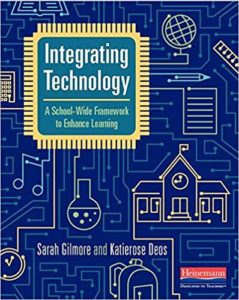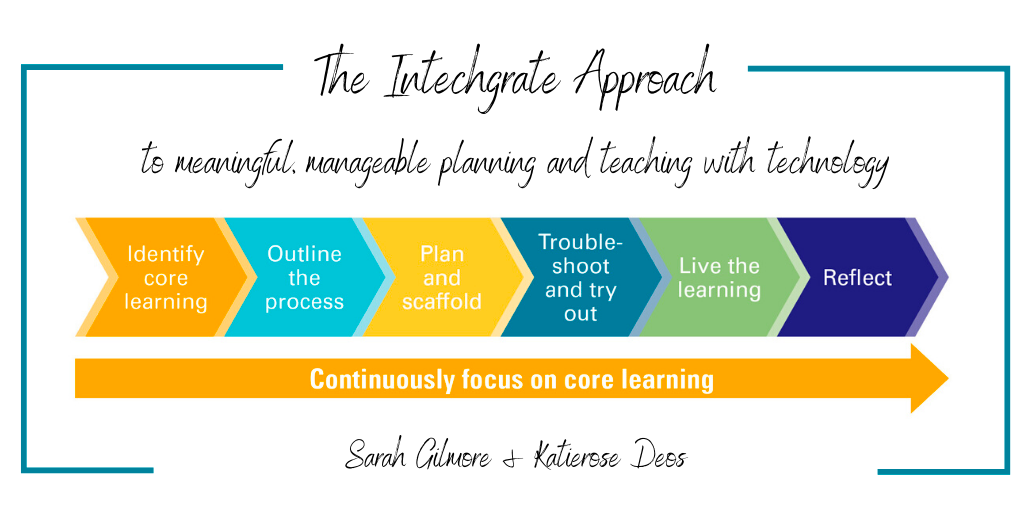A Vision of Schoolwide Technology Integration
Integrating Technology: A School-Wide Framework to Enhance Learning
By Sarah Gilmore and Katierose Deos
(Heinemann, 2020 – Learn more)

I picked up a copy of Integrating Technology in mid-March of 2020, which, for New York at least, meant that it arrived just as I switched to remote teaching.
I thought there might be elements of the book that would help as I waded through my first foray into on-line teaching, but I couldn’t bring myself to read about technology integration after spending a day on the computer. So it sat for a while.

At the heart of Integrating Technology is the authors’ Intechgrate model, which they describe as a “holistic approach to developing and supporting technology integration in education” (p. 7).
The model includes the many facets that support technology integration: beginning with purpose and teacher mindset, exploring pedagogy and curriculum, and finally addressing leadership and resources. The Intechgrate model provides the structure for the book as Gilmore and Deos devote a chapter (or more) to each aspect.
Not a how-to handbook
As the authors state, this is “not a how-to handbook” (p.7) for integrating technology. Instead it is a philosophical look at how to approach integration. Even so, I found myself looking for practical tools. For example, while the authors include Illustrating Integration sidebars in several chapters, as a visual learner, I wanted more detailed vignettes that would allow me to “see” technology integration in action. A check list or survey sample would have been a welcome addition. In this same vein, this book does not provide a discussion of specific apps and their uses outside of the Illustrating Integration features.
Gilmore and Deos do encourage readers to seek out, visit, or speak with “schools or teachers outside [their] own immediate context who are integrating technology innovatively, creatively, or just differently” (p.117). To facilitate this, readers can join the Twitter community or Facebook group of likeminded educators following Gilmore and Deos’s hashtag.
Targeting an expansive audience
The authors set forth an ambitious goal, writing the book for “everyone involved in education because the conversation of why and how we can use technology to enhance learning is not just a pedagogical conversation, or a leadership conversation, or a financial conversation: it is an educational conversation” (p. xvii). While lofty, this goal also proved to be unwieldy.
At the heart of this decision, I believe, is Gilmore and Deos’s position that all stakeholders should be fully a part of the task of technology integration. However, it means that the authors are writing for teachers, administrators, curriculum designers, and IT staff. It means they’re writing for those who are fluent in technology use and those who are wary of it. It means that they’re writing for pre-service teachers and veterans.
As a result, the early sections on pedagogy and curriculum seem more geared towards teachers, while later chapters are written for IT personal and school leaders. While I understand their stance that teachers and administrators need to become conversant in the language of devices, infrastructure, and systems, and conversely that IT staff will benefit from understanding the ways in which technology is being used, it seemed that the audience shifted from chapter to chapter rather than being inclusive and “all in education” throughout.
For instance, chapter 9: “Leading Technology Integration” provides a recap of the book, chapter by chapter, before exploring the leadership role, setting the expectation that a team leader might read only that chapter and skim back to previous chapters if he or she required further information.
On the other hand, reflection questions at the end of each chapter give ways for those who support student learning, teacher learning, curriculum development, and organizational systems and structures to engage with the material presented.
Ultimately, I see this book as a useful tool for a committee comprised of multiple stakeholders as they explore the process of Technology Integration together.
Applying the Intechgrate model
Veteran and pre-service teachers who are looking for a thoughtful model for using technology in the classroom will find the earlier chapters helpful. In particular, the Intechgrate approach, which draws on the principles of backward design to ensure that technology use is aligned with learning goals, stresses the importance of testing out the technology before the class and creates space for reflection after the lesson. This and other materials are also available in a set of online resources.
In the 2020-21 school year, technology will provide a lifeline that keeps school communities intact. But as we move beyond the COVID-19 pandemic, I hope we can step back and reflect on what we’ve learned about technology in education. I hope we can cleave to the practices that support student learning and discard those that do not.
To end on an upnote, when we are ready to revisit intentional technology use in the classroom, Gilmore and Deos’s Intechgrate Approach and Model will provide a path forward.
Jeny Randall is the Middle School Director and 6th-grade LA and science teacher at Saratoga Independent School in New York State. She also oversees the curriculum and program development for grades 6-8. Jeny is a Responsive Classroom certified teacher. Outside of school Jeny teaches yoga, reads whatever students send her way, and spends time with her family, outside if possible.


































